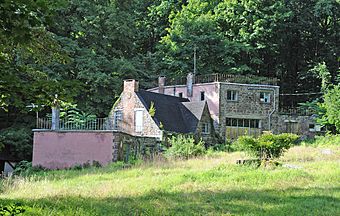Henry Varnum Poor House facts for kids
Quick facts for kids |
|
|
Henry Varnum Poor House
|
|
 |
|
| Nearest city | S. Mountain Rd., New City, New York |
|---|---|
| Area | 5.3 acres (2.1 ha) |
| Architect | Poor, Henry Varnum |
| Architectural style | Bungalow/Craftsman, Modern Movement |
| NRHP reference No. | 07001258 |
| Added to NRHP | December 11, 2007 |
The Henry Varnum Poor House, also known as "Crow House," is a historic home in New City, New York. It sits on South Mountain Road in Rockland County, New York. This unique house was built by a famous artist named Henry Varnum Poor.
Henry Varnum Poor built the house over many years, from about 1920 to 1949. It's special because it mixes two different styles of architecture. It has parts that look like the rustic Arts and Crafts Movement. This style focuses on handmade items and natural materials. The house also has parts that look like the Modern movement. This style uses clean lines and new ideas.
Contents
The Crow House Property
The Henry Varnum Poor House is more than just a home. It's a whole property with several interesting buildings. These were also built by Henry Varnum Poor.
What's on the Property?
- A studio built in 1957, where the artist likely worked.
- A small mill building from 1921, made with a half-timbered style.
- A woodshop built around 1920 to 1930.
- An outdoor kiln from 1957, used for firing pottery.
- A bridge built around 1950.
- A beautiful terraced garden from 1926.
All these parts show how Henry Varnum Poor lived and worked. They give us a peek into his artistic life.
Protecting This Special Home
The Henry Varnum Poor House is very important. Because of its history and unique design, it was added to the National Register of Historic Places in 2007. This list helps protect important places in the United States.
How It Was Saved
Around the same time it was listed, the town of Ramapo bought the house. They paid $1.3 million for it. The New York State helped with a grant of $496,000. This purchase helped make sure the house would be preserved for the future. There were also plans to add art and furniture from Henry Varnum Poor's family.



